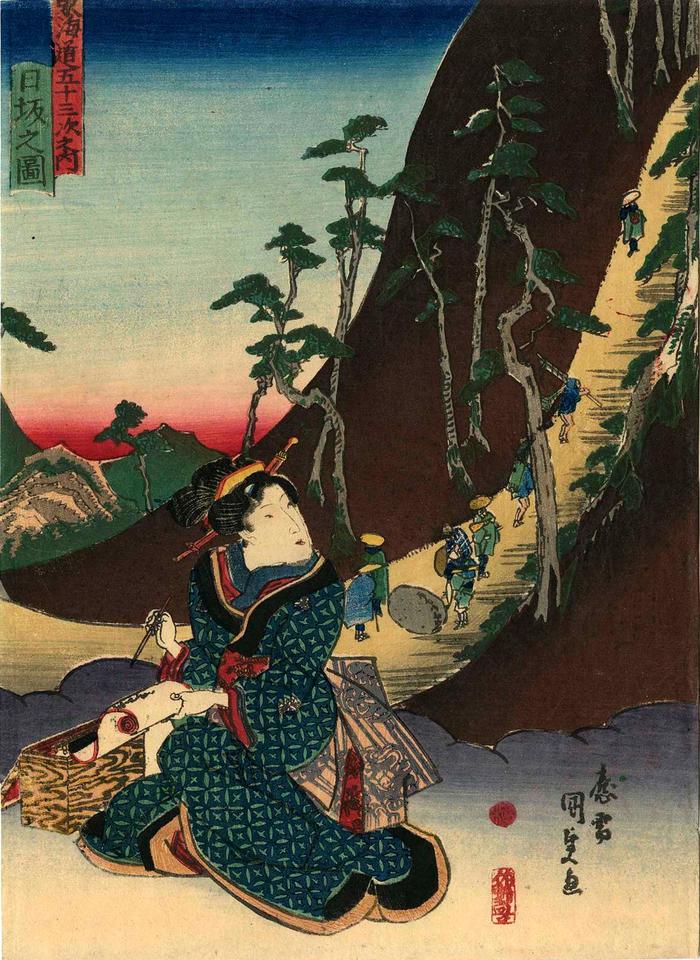Utagawa Kunisada (歌川国貞) / Toyokuni III (三代豊国) (artist 1786 – 01/12/1865)
View of Nissaka (Nissaka no zu: 日坂之圖) from the series Fifty-three Stations of the Tōkaidō Road (Tōkaidō gojūsan tsugi no uchi: 東海道五十三次之内)
1838
Signed: ōju Kunisada ga (応需国貞画)
Publisher: Sanoy Kihei
Censor's seal: kiwame
Museum of Fine Arts, Boston - published by Moriya Jihei
Museum für angewandte Kunst, Vienna
Lyon Collection - the Nightly Weeping Rock of Nissaka by Kuniyoshi
Honolulu Museum of Art
Achenbach Foundation - Hiroshige Nissaka print
National Diet Library - published by both Moriya Jihei and Sanoya Kihei
Spencer Museum of Art - published by Moriya Jihei
Bryn Mawr
The Sidney and Lois Eskenazi Museum of Art, the University of Indiana
Ishikawa Prefectural Museum of Art - dated to 1836
Berkeley Art Museum and Pacific Film Archive at the University of California
Fujisawa Ukiyo-e Museum
Victoria and Albert Museum
Nelson-Atkins Museum of Art All of the prints in this series are chūban sized. The example of this print in the collection of the Museum of Fine Arts in Boston is 9 13/16 x 7 5/16 in. This one in the Lyon Collection is fractionally smaller because it has been trimmed slightly at the top and along the left side.
****
Patrick Carey wrote on pages 78-79 in Rediscovering the Old Tokaido: In the Footsteps of Hiroshige that finding the exact locations was not an easy task considering all of the changes that have taken place since Hiroshige's day. After several attempts and using the best possible logic Carey eventually found 'The Night Wailing Stone'.
"Once upon a time, a pregnant woman was travelling this way. She stopped to rest on a stone. A robber was lying in wait. He attacked her with his sword, damaging it against the stone in the process. As she lay dying, she gave birth. The baby was found by a Buddhist monk who brought the child up to be a master swordsmith. The woman's spirit, meanwhile, had entered the blood-stained stone and each night the stone could be heard wailing. This is why it is called the Yonaki Ishi, the stone that cries at night."
"Years later, the robber took his sword to be mended. Foolishly, he confessed how the damage had occurred. The master swordsmith avenged his mother's death by felling his customer on the spot, with a single stroke."
****
This is number 26 in the series, based on the earlier landscape designs by Hiroshige.
Notice the rock in the middle of the road in the background. That is the Nightly Weeping Rock. For more about that story click on the Lyon Collection link of the Kuniyoshi shown above. Also, if you look carefully at this print by Kunisada you will see an inscription written on the rock and several travelers have stopped to examine it. We don't have a translation yet of that inscription, but will get it for you as soon as we know what it is.
Update as of July 15, 2021: the inscription on the stone is Namu Amida Butsu (南無阿弥陀仏) or 'Hail Amitabha Buddha'. Our source is In Hiroshige: l'art du voyage, Paris, 2012, p. 75.
****
In Tokaido Landscapes: The Path from Hiroshige to Contemporary Artists, 2011, #26, p. 38, speaking of the original Hiroshige print it says in a text by Sasaki Moritoshi: "The Night-Crying Stone, a landmark in Nissaka, lies in the middle of the road. Five travelers surround the rock, recalling the legend of a baby who was born after her mother was murdered here and was found crying near the rock. The rock is in the center of the frame, in the position of the hinge of a folding fan. The rising slope on the right is extremely steep. The rock functions as a weight that stabilizes the slope.... Two different rocks that are said to be the Night-Crying Stone exist today."
In another section of Tokaido Landscapes: The Path from Hiroshige to Contemporary Artists is a section with prints by Munakata Shiko loosely inspired by the original Hiroshige Tōkaidō series. The artist also wrote the commentaries to accompany these prints. Of the "Weeping Stone" he wrote on page 88: "This is the famous "weeping stone of Sayo" at the ridge of Say. In Hiroshige's woodblock, it was in the middle of the highway. It has since been moved to a small park and encased in a rather ugly arbor. it was probably in February, with plum blossoms blooming. In their fragrant smell, I made this drawing. However, the ink ran no matter how many times we prints this woodblock. Specialists call it "weeping." Perhaps because it depicted the weeping stone, the ink wept. This is the third of my seven wonder."
****
A Yonaki-ishi (夜泣き石) is the term used for a 'night-crying stone'.
****
Sayo no nakayama (小夜の中山) is the name of this mountain pass where the weeping rock can be found. In fact, the term 'sayo no nakayama' is part of the title of the Hiroshige print of this location. While Hiroshige might have exaggerated the steepness of this location, it is still consider one of the three most difficult parts of the Tōkaidō to hike, along with Hakone and Suzuka.
****
Illustrated in a small color reproduction in Kunisada's Tokaido: Riddles in Japanese Woodblock Prints by Andreas Marks, Hotei Publishing, 2013, page 69, T24-26.
Sanoya Kihei (佐野屋喜兵衛) (publisher)
landscape prints (fūkeiga 風景画) (genre)
beautiful woman picture (bijin-ga - 美人画) (genre)
